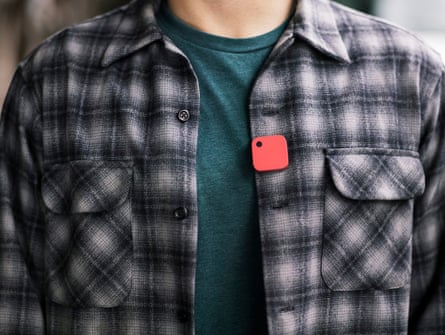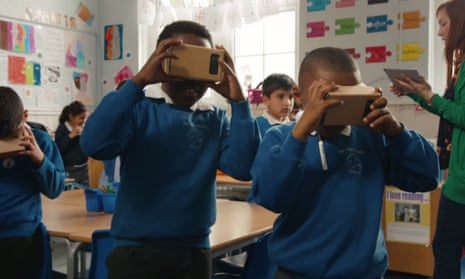The terracotta brickwork of the Great Wall of China transfixes a group of students, who reach out to touch the stone in front of them. But these children are not in east Asia. Instead, they’ve been magically transported to the historic monument by a virtual reality (VR) headset.
They are using Expeditions, a new classroom initiative unveiled by Google in May. The inexpensive cardboard contraption – literally a folded piece of cardboard with lenses attached – turns a smartphone into a VR viewer.
More than 100 classes have already used it to transport students to places such as Verona in Italy to study Romeo and Juliet and California to explore a coral reef.
“The creativity we have seen from teachers, and the engagement from students, has been incredible,” says Google’s Ben Schrom, product manager for Expeditions.
This viewer is one of a growing number of “wearables” – a fuzzy term that refers to any device you can wear (think headsets, fitness trackers and smartwatches) – that could soon be a regular fixture in classrooms. It’s still early days and few schools are even aware of this new breed of devices. But as the technology becomes more advanced, less expensive and more accessible, opportunities will grow.
Many up-and-coming devices fall into the wearables category, from VR devices to augmented reality (AR) gear like Microsoft’s HoloLens. Whereas VR creates a completely contained digital experience, AR overlays digital graphics on top of the real world – enabling you to, among other things, play Minecraft on your living room table.

Then there are “life-logging” devices like Autographer or Narrative Clip – tiny cameras that capture snapshots of the day and provide an edited highlight reel of photos every evening.
Brain-sensing headband Muse, meanwhile, can tell you how your class reacts to certain activities, and which are most conducive to learning. It works by monitoring brain signals in the same way that a heart rate monitor tracks your pulse. When Muse spots patterns that equate to distracted thoughts, it uses audio prompts to get you back on track – the aim is to train your brain to stay focused.
One of a small number of teachers already working with wearables in the classroom is Margaret Powers, a technology coordinator from Pennsylvania, US. Her 365 Days of Glass blog is an exploration of how the experimental AR Google Glass headset can make a difference to education, by documenting field trips and conducting experiments, for example.
“Glass works best for capturing documentation of student learning and discovery, either from a student’s perspective or from the teacher’s,” Powers says. “I think other devices like the Apple Watch and Google Cardboard offer some exciting possibilities for education. I envision teachers or even students using wearables to help monitor when they need to take a brain break and stretch and run, or practise some mindfulness. There is a lot of potential for innovation.”
Powers adds that these devices could empower students and teachers to look at learning throughout the day and reflect on their working patterns. She also hopes they will enable more global partnerships between classrooms, so after touring another country on a virtual field trip through Cardboard, students could use Glass to have a Google Hangout with students there.
Jason Higgins, managing director at the Harmony augmented reality studio in Bedfordshire, says that AR and similar immersive technologies can be powerful learning tools when used to visualise complicated subject matters. The Brain AR app, for example, lets students explore the brain in a fully immersive 3D environment. The models are colour-coded and provide information about the tissues, structures and areas of the mind.
“The key benefit is that users can explore and interact at their own pace, allowing for simplified review of learning,” Higgins explains. “Studies show that AR can also increase the speed and retention of learning in addition to widening the spectrum of accessibility within groups of pupils.”
But there’s still a lot of work to do. These wearables have barely broken through into the consumer market – Microsoft HoloLens isn’t expected to go on sale until December at the earliest, and Facebook’s Oculus Rift VR headset won’t be available until 2016 – so understanding how they can have an impact in the classroom will take time.
“I do think technology can sometimes be a distraction to learning and I’ve yet to see any real value in wearable technology in school,” says David Andrews, educational consultant and director of Mr Andrews Online. “I can see real value in Google Expeditions, although I would like to see it in action first. It could potentially be a stimulus for learning, promoting spoken language, leading on to creative writing projects in lots of different subjects — geography, history, science and so on.”
Higgins agrees that there are issues to overcome. “Wearable technology is still relatively expensive, cumbersome and can lack a fluidity of use,” he says. “In time, specialist educational technology will make the process of deploying relevant content into the classroom much easier but, for now, it is a case of utilising what is available as the technology embeds itself into the new markets.”
There’s little standing in the way of teachers experimenting with wearable technology into the classroom, even if the hardware and software could still use a few tweaks. Google Expeditions, for example, is gearing up for a full launch in the autumn.
As Google’s Ben Schrom says: “Where does it go from here? It’s still early but we’re working with some amazing content and educational partners to create incredible learning experiences for children. It’s virtual reality, so the possibilities are, for once, endless.”
David Nield is a freelance journalist who has been writing about technology, apps, gadgets and the web since 2002.

Comments (…)
Sign in or create your Guardian account to join the discussion